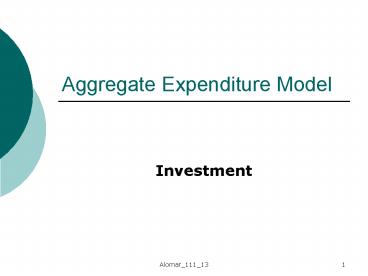Aggregate Expenditure Model PowerPoint PPT Presentation
Title: Aggregate Expenditure Model
1
Aggregate Expenditure Model
- Investment
2
Investment
- Is the second component of private spending
(beside C). - Investment consists of expenditure on new plants,
capital equipment, machinery, inventories - Investment decision marginal benefit vs.
marginal cost
3
- If expected rate of return gt interest rate of
borrowing funds invest - If expected rate of return lt interest rate of
borrowing funds not to invest - Note that investors take their investment
decision based on the real interest rate - Rnominal rate rate of inflation
4
Deriving the investment demand curve
- What determine the amount of funds that investors
borrow? - Real interest rate (rr) an increase in rr will
increase the cost of borrowing funds, thereby
reducing the amount of I. - A decline in rr will reduce the cost of borrowing
funds, thereby increasing I.
5
Investment Demand Curve (ID)
- rr
-
ID
6
Determinants of I
- Changes in the level of rr will lead to a move in
ID curve. - This is the only factor leading to a move along
the ID curve. - All other factors will shift the ID curve.
7
Other determinants of I
- 1. Acquisition, maintenance, and operating costs
The initial and then the operating cost of
capital affect the expected rate of return in I. - 2. Business Taxes increase in taxes will reduce
expected profitability.
8
- 3. Technological changes stimulates investment
and lower production costs. - 4. Stock of capital goods as inventories rise,
expected rate of return on investment increase.
9
- 5. Expectations EX(r) depends on firms
expectations about sales, future operation costs,
future profitability
10
Investment and Real Outputs
- We now related the level of (I) to the level of
real outputs and income. - We will assume that we have planned I that is
independent of the level of DI and real outputs. - This is the case since I level is instable.
11
Equilibrium GDP
- Now we combine both C and I to explain the
equilibrium level of outputs, income, and
employment. - The following table shows this process
12
(No Transcript)
PowerShow.com is a leading presentation sharing website. It has millions of presentations already uploaded and available with 1,000s more being uploaded by its users every day. Whatever your area of interest, here you’ll be able to find and view presentations you’ll love and possibly download. And, best of all, it is completely free and easy to use.
You might even have a presentation you’d like to share with others. If so, just upload it to PowerShow.com. We’ll convert it to an HTML5 slideshow that includes all the media types you’ve already added: audio, video, music, pictures, animations and transition effects. Then you can share it with your target audience as well as PowerShow.com’s millions of monthly visitors. And, again, it’s all free.
About the Developers
PowerShow.com is brought to you by CrystalGraphics, the award-winning developer and market-leading publisher of rich-media enhancement products for presentations. Our product offerings include millions of PowerPoint templates, diagrams, animated 3D characters and more.

